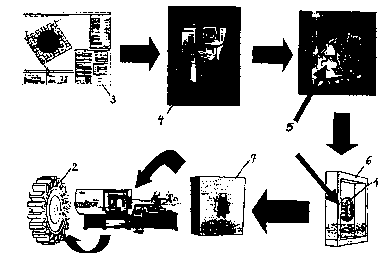Some of the information on this Web page has been provided by external sources. The Government of Canada is not responsible for the accuracy, reliability or currency of the information supplied by external sources. Users wishing to rely upon this information should consult directly with the source of the information. Content provided by external sources is not subject to official languages, privacy and accessibility requirements.
Any discrepancies in the text and image of the Claims and Abstract are due to differing posting times. Text of the Claims and Abstract are posted:
| (12) Patent Application: | (11) CA 2332798 |
|---|---|
| (54) English Title: | INJECTION MOULDING TOOL AND METHOD FOR THE PRODUCTION THEREOF |
| (54) French Title: | OUTIL DE MOULAGE PAR INJECTION ET PROCEDE DE FABRICATION DUDIT OUTIL |
| Status: | Deemed Abandoned and Beyond the Period of Reinstatement - Pending Response to Notice of Disregarded Communication |
| (51) International Patent Classification (IPC): |
|
|---|---|
| (72) Inventors : |
|
| (73) Owners : |
|
| (71) Applicants : |
|
| (74) Agent: | BLAKE, CASSELS & GRAYDON LLP |
| (74) Associate agent: | |
| (45) Issued: | |
| (86) PCT Filing Date: | 1999-05-18 |
| (87) Open to Public Inspection: | 1999-11-25 |
| Availability of licence: | N/A |
| Dedicated to the Public: | N/A |
| (25) Language of filing: | English |
| Patent Cooperation Treaty (PCT): | Yes |
|---|---|
| (86) PCT Filing Number: | PCT/CH1999/000211 |
| (87) International Publication Number: | WO 1999059790 |
| (85) National Entry: | 2000-11-14 |
| (30) Application Priority Data: | ||||||
|---|---|---|---|---|---|---|
|
The inventive method for the production of a metal mould in order to
manufacture a limited amount of mass-produced injection moulded parts (2)
consists in producing a moulded part (7) by means of injected powder moulding
based on a model for said injection moulded part (2) and in producing a tool
therefrom by means of debinding and sintering.
Procédé de fabrication d'un moule de moulage par injection en métal pour la production en série limitée de pièces (2) moulées par injection, qui consiste, sur la base d'un modèle (1) de la pièce (2) à mouler par injection, à fabriquer une pièce de moulage (7) par moulage par injection de poudre, et à fabriquer un outil de moulage à partir de cette pièce de moulage par élimination du liant et frittage.
Note: Claims are shown in the official language in which they were submitted.
Note: Descriptions are shown in the official language in which they were submitted.

2024-08-01:As part of the Next Generation Patents (NGP) transition, the Canadian Patents Database (CPD) now contains a more detailed Event History, which replicates the Event Log of our new back-office solution.
Please note that "Inactive:" events refers to events no longer in use in our new back-office solution.
For a clearer understanding of the status of the application/patent presented on this page, the site Disclaimer , as well as the definitions for Patent , Event History , Maintenance Fee and Payment History should be consulted.
| Description | Date |
|---|---|
| Inactive: IPC deactivated | 2021-11-13 |
| Inactive: IPC assigned | 2021-08-20 |
| Inactive: IPC expired | 2017-01-01 |
| Inactive: IPC from MCD | 2006-03-12 |
| Time Limit for Reversal Expired | 2005-05-18 |
| Application Not Reinstated by Deadline | 2005-05-18 |
| Inactive: Abandon-RFE+Late fee unpaid-Correspondence sent | 2004-05-18 |
| Deemed Abandoned - Failure to Respond to Maintenance Fee Notice | 2004-05-18 |
| Inactive: Entity size changed | 2003-05-22 |
| Letter Sent | 2003-05-21 |
| Reinstatement Requirements Deemed Compliant for All Abandonment Reasons | 2003-05-02 |
| Deemed Abandoned - Failure to Respond to Maintenance Fee Notice | 2002-05-21 |
| Inactive: Cover page published | 2001-03-09 |
| Inactive: First IPC assigned | 2001-03-07 |
| Inactive: Inventor deleted | 2001-02-28 |
| Inactive: Notice - National entry - No RFE | 2001-02-28 |
| Application Received - PCT | 2001-02-27 |
| Application Published (Open to Public Inspection) | 1999-11-25 |
| Abandonment Date | Reason | Reinstatement Date |
|---|---|---|
| 2004-05-18 | ||
| 2002-05-21 |
The last payment was received on 2003-05-02
Note : If the full payment has not been received on or before the date indicated, a further fee may be required which may be one of the following
Please refer to the CIPO Patent Fees web page to see all current fee amounts.
| Fee Type | Anniversary Year | Due Date | Paid Date |
|---|---|---|---|
| Basic national fee - small | 2000-11-14 | ||
| MF (application, 2nd anniv.) - small | 02 | 2001-05-18 | 2001-04-18 |
| MF (application, 3rd anniv.) - standard | 03 | 2002-05-21 | 2003-05-02 |
| Reinstatement | 2003-05-02 | ||
| MF (application, 4th anniv.) - standard | 04 | 2003-05-20 | 2003-05-02 |
Note: Records showing the ownership history in alphabetical order.
| Current Owners on Record |
|---|
| JEAN-MARC BOECHAT |
| Past Owners on Record |
|---|
| None |